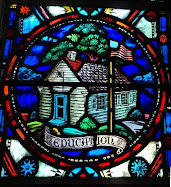 Miss Charlotte Mason was a late 19th / early 20th century leader in British education. Her Parents National Educators Union schools, in homes and villages around that country, championed natural learning methods, high quality literature, the fine arts, orderly home atmosphere, healthy outdoor time, and the dignity of the child.
Miss Charlotte Mason was a late 19th / early 20th century leader in British education. Her Parents National Educators Union schools, in homes and villages around that country, championed natural learning methods, high quality literature, the fine arts, orderly home atmosphere, healthy outdoor time, and the dignity of the child. Her methods, outlined in the six volume Original Home Schooling series, have made a comeback in modern home schooling circles where they are also known as “living books” or “life experiences” education. Mind you, I haven’t yet been able to plow through all of her own writings, but I do appreciate the books and magazine articles I have read about them. If I had to choose one approach to home schooling, this would be it!
For language we use dictation, copy work and narration; choose interesting “whole books” written by authors with a passion for their subjects; and teach children to read with a commonsense blend of phonics and sight words. There are so many other ways we have used Charlotte Mason to appreciate art and nature, but to list them would start another whole chapter! My favorite book on this is The Charlotte Mason Companion by Karen Andreola.
The Best Facets of Charlotte Mason
♥ Choose interesting “living books” and biographies for reading aloud or independent study.
♥ Keep lessons short and varied so that the mind does not become dull.
♥ Assess comprehension by oral or written narration (the student tells what he has learned).
♥ Use the methods of dictation and copying to practice grammar, handwriting and spelling.
♥ Go on nature walks and draw what you see.
♥ Allow plenty of time for unstructured outdoor play.
♥ Study fine art and listen to excellent music, focusing on one artist or composer at a time.
The brief article above is excerpted from my first book, The Real Life Home School Mom.
Charlotte Mason Web Sites
Here is a collection of several popular web sites that teach about various aspects of the Charlotte Mason approach to education. Please note that I do not endorse everything on each site.
I recommend that if you see a link that interests you, either in this Charlotte Mason section or the next one on my blog links, that you right click and open in a new tab. That way you can read each one in turn without losing track of the others.
Charlotte Mason Research & Supply with Karen Andreola www.charlottemason.com/ (I'm not sure if this site has been updated recently since it doesn't list Karen's newest book, but there is still a lot of great stuff there.)
Ambleside On-line -- free curriculum, booklists, schedules, including free on-line texts, plus CM's original series in modern English paraphrase http://www.amblesideonline.org/
Simply Charlotte Mason http://simplycharlottemason.com/
~~~
I wrote a blog post called Nature Study: It's For the Birds! about a little bit of Charlotte Mason style nature study in our home and co-op. My sons Andrew, Micah, and Ben took the beautiful bird photographs in this post. Check it out! (Update in 2021: They are all adults now!)











































